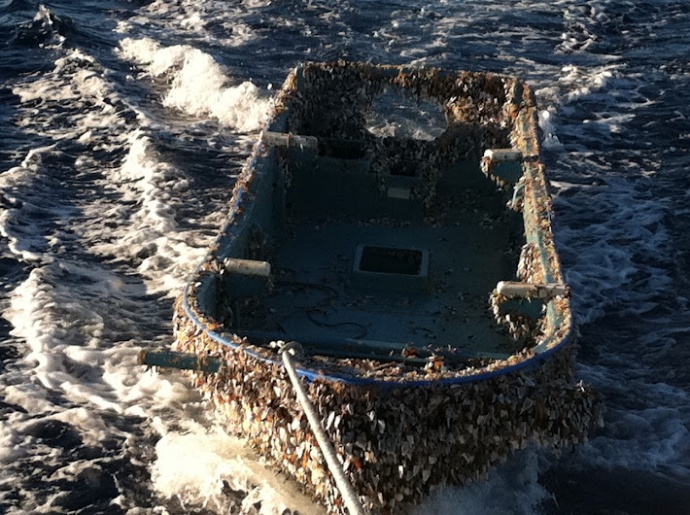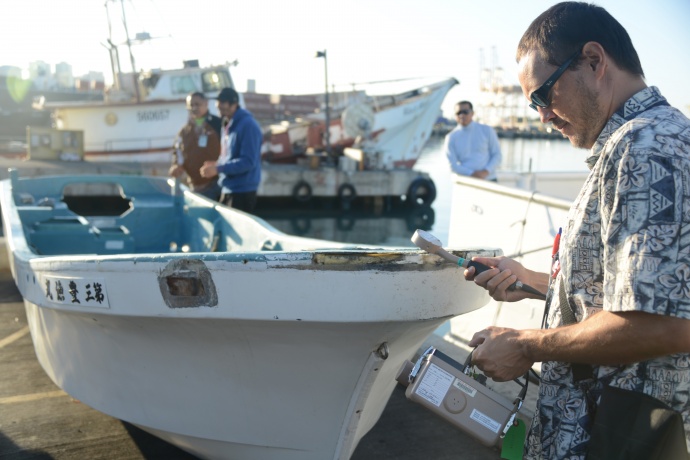VIDEO: Skiff From Japan Tsunami Found Off Maui

Gooseneck barnacles, a common open-ocean marine species, and crabs cover the skiff before it is cleaned. Photo courtesy P. Grillo.
[flashvideo file=http://www.youtube.com/watch?v=mYXY9rfxlR0 /] By Wendy Osher
The latest marine debris to arrive in Hawai’i from the Japan tsunami was recovered in waters off of Maui.
The 20 by 6 foot skiff was found by a Hawai’i longline fishing vessel about 700 nautical miles northeast of Maui, state officials said.
The Zephyr unloaded its catch at Pier 38 in Honolulu this morning, as crews from the state Department of Land and Natural Resources lead the coordinated response effort.
Among the agencies assisting DLNR in response were: the state Health Department, state Department of Transportation, National Oceanic and Atmospheric Administration, and the US Coast Guard.
Registration numbers found on the skiff were used to identify the vessel. Authorities confirmed that it was washed away during the 2011 tsunami where it was registered in the Iwate Prefecture.
“The State of Hawaii is grateful to the Japan Consulate for their continued excellent assistance to confirm origin of this item and contact the owner. This is believed to be the second confirmed piece of Japan tsunami marine debris in Hawai’i,” said William J. Aila, Jr., DLNR Chairperson.
Aila also confirmed that the department’s marine invasive species personnel inspected the skiff this morning and determined that it was completely clean of any marine organisms.
“When discovered, the skiff was covered with gooseneck barnacles with some crabs mixed in, very similar to the composition found on the Suisan blue bin. It hauled aboard the F/V Zephyr where the crew did a very good job of cleaning it. This important step helps reduce the introduction of possible invasive species into Hawaii,” said Aila.

Joshua Marvit, State of Hawaii Dept. of Health, tests a skiff for radiation after the vessel was salvaged by the crew of the F/V Zephyr approximately 800 miles north of Honolulu, Oct. 5, 2012. The skiff was confirmed to have been debris from the 2011 Japan Tsunami by the Japanese Consulate, after they contacted the owners through the Japanese Ministry of Foreign Affairs, and confirmed that they did not seek its return. The Department of Land and Natural Resources and the State of Hawaii Department of Health conducted radiation tests and a search for invasive species as a precautionary measure. US Coast Guard photo by Petty Officer 2nd Class Eric J. Chandler.
Personnel with the Department of Health also checked the skiff for any radiation, which showed normal background levels, similar to other debris objects that arrived.
“We appreciate that this fisherman reached out to us and our partners at the Coast Guard and DLNR to alert us of the skiff and determine appropriate measures to take,” said Carey Morishige, NOAA’s Marine Debris Program Pacific Islands regional coordinator in a media statement this afternoon. “Boaters are our eyes on the water and we need their help to be on the lookout for marine debris.”
The public can report findings of possible tsunami marine debris by contacting DLNR at (808) 587-0400. If possible, officials request that a picture of the debris with a detailed description of the object, date found, location and finder’s contact information, be sent to [email protected] . This information will help DLNR staff to determine if a more thorough investigation is necessary.
More detailed guidelines on reporting and/or handling marine debris can be found at http://marinedebris.noaa.gov/tsunamidebris.
Last month, a large blue plastic fishing bin was confirmed as the first official piece of Japan tsunami marine debris to arrive in the islands.
Since then, Hawai’i residents have reported a number of other items including: pieces of Styrofoam, large buoys typically used in oyster farming, a large rubber float, a beer crate, tire, plastic containers, hard hat, and large light bulbs.
“Our outdoor lifestyles mean that there are many of us who will find and can report items, especially those which may be covered with marine organisms or writing. We encourage the public to continue to help pick up and remove marine debris and litter from our beaches, when safe to do so,” said Aila in a statement today.
***Supporting information courtesy Hawai’i DLNR.










